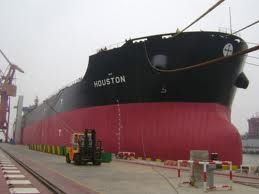
The adverse conditions which have been put in place in the world's freight markets, means that ship owners are forced to scrap vessels of a much younger age than before, in a reversal of the trend established during the industry's "golden years" of the past decades, when older vessels were kept in service for much longer than originally intended. In a recent report on the current demolition trends, shipbroker Intermodal noted that "since the second half of 2009 that we initially felt the big drop in freight rates, the problem of excess tonnage in the market has been top on everyone’s agenda. All parties involved in the shipping industry had voiced their concerns and agreed that demolition is going to be the only fast way to escape from the current unfavorable conditions. This meant that all the early/mid/late 80’s vessels would ideally have to head to the breakers’ yards even if they had been well maintained or had their trading certificates valid for many more years" it said.
The report from Intermodal's Panos Makrinos continued by mentioning that "four years have gone by since then and with a significant number of these 80’s built vessels having already been removed from active service, we are still facing a problem of an ever growing fleet at an extraordinary rate. It seems as though the scrapping age will continue to drop as freight levels continue to dwindle at their current unviable levels. We have already started to see several 90’s built vessels going for scrap with good examples being the two Capesize bulkers and Suezmax Tankers of ‘’FRONTLINE MANAGEMENT’’ which had been sold earlier this year to sub-continent buyers for demolition" it said.
Makrinos added that "our feeling is that if the freight market continues to have the same uncertainty and poor prospects, it will be no surprise to us if we start to see a plethora of early 90’s built vessels being as sold for demo. Let’s not overlook the fact that the average age of scrapped dry bulk vessels has dropped from 31 years seen last year down to 28 years seen in 2012. Additionally, we had mentioned in our previous report; during 2012 the active bulker fleet has grown by 6% in vessels and 8% in DWT, this means that the overcapacity problem is still there as a serious headache for all ship owners, despite the fact that more than 33.5mil tons of DWT (approximately 713 ships) have been already removed from the active fleet from the beginning of this year.
Considering the above demo figures and expected N/B deliveries within the last quarter of 2012 and first months of 2013, the only hope for the future of shipping is the magic word demolition… However, the question that arises here for one more time is whether this common thinking is indeed correct and able itself to recover the current uncertain situation, as well as for how long will demo Buyers buy vessels at attractive levels and will the current prices be able to be supported in the case that demand for steel and iron ore moves further down.
Demo prices have been fairly volatile these past couple of weeks, leaving a lot of uncertainty with regards to the direction the market will take in the medium-term. As per last done deals, demo prices in the sub-continent are currently between USD 395 - 410 per lightweight for bulkers and for tankers around USD 420 - 440 per lightweight" the report concluded.
Meanwhile, in the dry bulk markets this week, the Capesize segment "hit the ground running this week, despite a Bank Holiday in London. An injection of fresh cargo, largely down to numerous typhoons across the Pacific, was followed by a flurry of fixing on WA/China routes with the rate rising steadily since Monday morning. WA/China rates are very positional at present, with prompt tonnage achieving a reported high of usd 7.80 pmt, whilst tonnage eta 10-14 Sep has been fixing up to around usd 7.25 pmt. The Pacific RV index has improved in line with these gains, standing at usd 4,361 at the time of writing. The Atlantic has shown more tentative improvement, with some Columbian coal now moving but spot vessels keeping a lid on rates. The Atlantic RV currently stands at usd 2,950, whilst a reported usd 17.75 pmt was last done for Tubarao/Qingdao basis mid September dates" said the latest weekly report from Braemar Seascope.
Commenting on the Panamax front, it said that "Panamax Owners endured yet another week of attrition, with insufficient cargo and declining rates. Any hoped for input of fresh cargo for the Atlantic market failed to happen and looking forward, the outlook is negative with the U.S. drought situation unlikely to deliver any good news for the coming Autumn grain harvest and export programme. There are many vessels in ballast towards the Atlantic from the Pacific. The Pacific has also seen limited fresh cargo and with many spot/prompt vessels around, there is no chance for Owners to halt the further downward trend" Braemar concluded.
Nikos Roussanoglou, Hellenic Shipping News Worldwide
We use cookies to improve your experience. By continuing to use our site, you accept our Cookies, Privacy Policy,Terms and Conditions. Close X